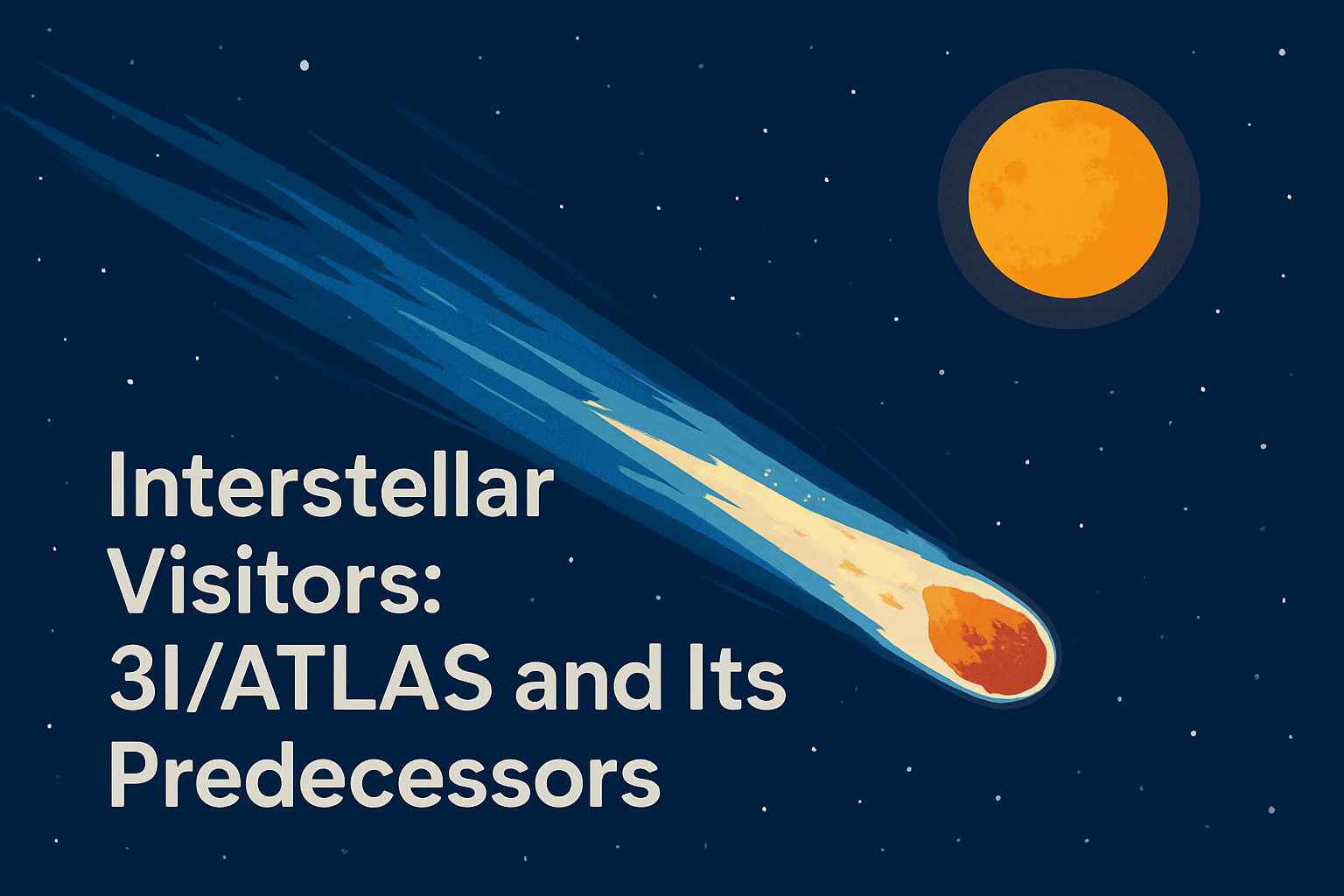
🌟 Meet Our Young Scientist Contributor! 🌟
This article was written by Dhruv Pothukuchi, a 9-year-old science enthusiast from Leadership Preparatory School(Teel, Frisco, TX), Grade 4. Dhruv loves exploring space and technology, and his curiosity led him to research and write about interstellar visitors like 3I/ATLAS.
We are proud to feature Dhruv’s work in Kids Science Magazine as part of our Young Scientists’ Corner, which celebrates original articles written by children who are passionate about science and technology. 👏✨
Interstellar Visitors: 3I/ATLAS and Its Predecessors
3I/ATLAS (C/2025 N1, formerly A11pl3Z)
3I/ATLAS, also designated C/2025 N1 (ATLAS) and previously known as A11pl3Z, is an interstellar comet discovered by the Asteroid Terrestrial-impact Last Alert System (ATLAS) survey at Rio Hurtado, Chile, on 1 July 2025 [1]. At the time, it was about 4.5 au (≈ 670 million km) from the Sun [2].
Its trajectory is hyperbolic (unbound to the Sun), with a large excess velocity confirming it originated outside the solar system [2]. The object will not approach Earth closely — its minimum distance is estimated at ~1.8 au (≈ 270 million km) — so there is no impact threat [2].
💡 Did You Know?*
3I/ATLAS is only the third confirmed interstellar object ever discovered! That means it came from outside our solar system—like a visitor from another star system zooming past the Sun!
Hubble observations on 21 July 2025 revealed a dust coma surrounding a hidden nucleus. From these data, astronomers estimate the nucleus is smaller than 5.6 km in diameter [4]. The precise size remains uncertain because much of the observed brightness comes from dust and gas [4]. ATLAS is considered an active comet, showing clear outgassing and a faint tail as it approaches its perihelion (~1.4 au from the Sun on 30 October 2025) [2][5].
Comparisons: ‘Oumuamua and Borisov
‘Oumuamua (1I, 2017 U1)
Discovered in October 2017, ‘Oumuamua was the first confirmed interstellar object [6]. Unusually, it showed no visible coma or tail, yet exhibited non-gravitational acceleration as it left the solar system [6]. This led to debates about its nature.
Hypotheses include outgassing of exotic ices (e.g. molecular hydrogen, nitrogen ice) [7][8]. Its shape was inferred as highly elongated, with estimates ranging from a cigar-like to pancake-like geometry, depending on modeling [8].
💡 Did You Know? *
Scientists weren’t sure if ‘Oumuamua was shaped like a long cigar or a flat pancake! They had to guess based on how it reflected sunlight.
Borisov (2I, 2019 Q4)
In contrast, 2I/Borisov looked like a typical comet, with a bright coma and dust tail [9]. It was discovered by amateur astronomer Gennady Borisov in August 2019. Observations indicated unusually high carbon monoxide levels compared to solar system comets, suggesting it formed in a colder stellar system, possibly around a red dwarf [9]. Because it was detected earlier in its passage, astronomers had more time to study it in detail, making it the best-observed interstellar comet to date.
💡 Did You Know?*
2I/Borisov had more carbon monoxide than comets in our solar system, which means it probably formed around a very cold star—maybe a tiny red dwarf!
Social Media & Speculative Theories
Because interstellar objects are rare, they often fuel speculation online. These ideas are popular but not supported by scientific consensus:
- Alien lightsail or probe: Avi Loeb and others suggested that ‘Oumuamua could be an artificial solar sail [6]. This theory gained traction on social media but remains unproven.
- Mothership or targeting Earth: Some online communities speculated that ATLAS was a colossal alien ship deliberately maneuvering toward Earth. No evidence supports this.
- Fabricated claims: Viral posts falsely attributed statements about interstellar comets to public figures (e.g. Elon Musk). These are misinformation.
- Exaggerated size claims: Some posts described ATLAS as 10–20 km wide, but Hubble data show the nucleus is much smaller (<5.6 km) [4].
💡 Did You Know? *
Social media often makes these space objects seem much scarier or bigger than they really are. Scientists rely on real observations from telescopes like Hubble to know the truth!
Conclusion
The discoveries of ‘Oumuamua, Borisov, and now ATLAS mark milestones in astronomy. Each interstellar object offers a fleeting but powerful chance to study materials from beyond our solar system. While social media often amplifies speculative theories, rigorous observations remain our best tool to understand these rare visitors.
As detection technologies improve, more interstellar objects will likely be found, each expanding our knowledge of the galaxy and the diversity of planetary systems within it.
References
- NASA (2025). NASA Discovers Interstellar Comet Moving Through Solar System. science.nasa.gov
- NASA (2025). 3I/ATLAS Overview. science.nasa.gov
- The Planetary Society (2025). Studying a Distant Visitor: What We Know About Interstellar Object 3I/ATLAS. planetary.org
- NASA APOD (2025). Interstellar Comet 3I/ATLAS from Hubble. apod.nasa.gov
- NASA APOD (2025). Comet 3I/ATLAS Approaches the Sun. apod.nasa.gov
- Micheli, M. et al. (2018). Non-gravitational acceleration in the trajectory of 1I/‘Oumuamua. Nature.
- Seligman, D. & Laughlin, G. (2020). Exotic ices as the origin of ‘Oumuamua. ApJ Letters. arxiv.org
- Desch, S. & Jackson, A. (2021). Nitrogen ice fragments as a possible origin for ‘Oumuamua. JGR: Planets.
- Guzik, P. et al. (2020). Comet 2I/Borisov: Composition and activity. A&A.
Did You Know? * (Added for fun and clarity; NOT part of Dhruv’s original work!)
📝 Do You Want to Publish Your Science Article Too?
At Kids Science Magazine, we love celebrating young minds who are curious about science and technology. If you’re a student with a passion for exploring the world and want your article featured on our website, we’d love to hear from you!
👉 Here’s how to contribute:
- Write an article on any science or technology topic of your choice.
- Include references for where you found your information.
- Ask your parent/guardian to send us your work along with their written consent to publish.
- Email your article to KidsScienceMagazine@gmail.com as an attachment.
Your work might be featured in our Young Scientists’ Corner! 🌟
